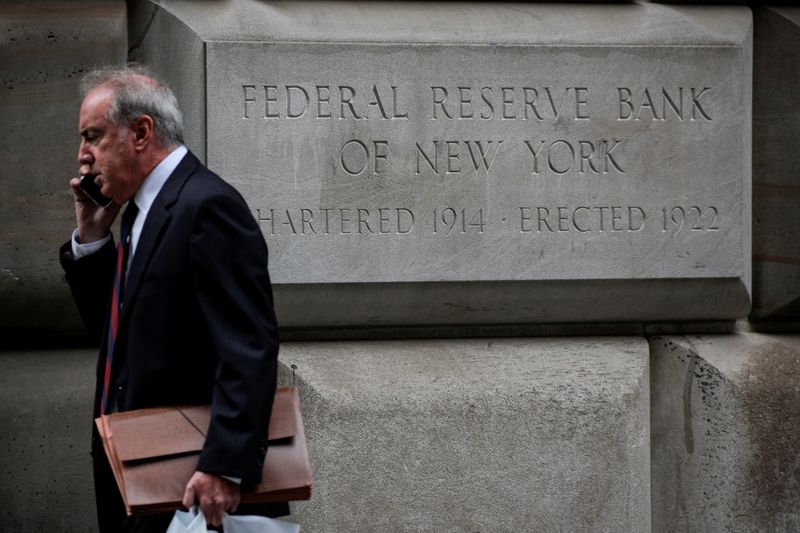
© Reuters. FILE PHOTO: A man walks outside The Federal Reserve Bank of New York in New York City, U.S., October 12, 2021. REUTERS/Brendan McDermid
By Michael S. Derby
NEW YORK (Reuters) – International supply chain stress continued to ease last month, the Federal Reserve Bank of New York said on Thursday, in data that suggests at least some of the pressure that has been pushing inflation higher is abating.
The bank said that as of March, its Global Supply Chain Pressure index moved to a reading of -1.06, versus the revised -0.28 seen in February. Global supply chain issues, which have been a key driver of higher inflation, peaked in December 2021 and have for the most part been falling since that point. Negative readings point to pressures that are below the historical average.
“Global supply chain conditions have largely normalized after experiencing temporary setbacks around the turn of the year,” the bank said in its report. The latest easing in logistics-related issues was tied to European backlogs and delivery times, as well as developments in Taiwan.
March’s reading was the lowest since the -1.2 seen in August of 2009. The index has seen extended periods of below-average supply chain stress and was in negative territory during the summer of 2019, ahead of the onset of the coronavirus pandemic. There was also an extended period of below-normal supply chain stress between roughly 2011 and 2016.
The New York Fed index points to ongoing improvements in the kinks that had once been a major driver of the highest levels of inflation seen in the U.S. in decades. Surging price pressures have driven the Fed to embark on a very aggressive campaign of raising its short-term rate target to bring inflation, which was 5% by a key measure in February, back to the central bank’s 2% target.
“On the supply side of the economy, disruptions in supply chains have generally improved, although not uniformly,” Cleveland Fed President Loretta Mester said in a speech Tuesday. “This is welcome news because price pressures can be alleviated both through further moderation in demand and further improvement in supply,” she said.
Still, as supply chains become less affected by logistics- related troubles, the Fed’s efforts to get inflation down further will become more challenging, as inflation emanates from parts of the economy that are less reactive to changes in short-term borrowing costs, such as the service sector.
Speaking on Friday, New York Fed President John Williams described a layered environment for inflation. Higher interest rates have cooled upward price pressures for goods, as he noted, “supply-chain bottlenecks that plagued the economy earlier in the pandemic have receded, which is also helping bring goods price inflation down.”
But price pressures driven by non-energy service factors stripped of housing are “having the most trouble” abating, Williams said. Those forces are “influenced by the balance of overall supply and demand for these services and labor, and it will likely take the longest to bring inflation in this sector down fully,” he said.
The Fed has penciled in one more rate hike for this year and officials generally expect inflation to decline slowly. They reckon economic activity will be weighed on by tighter financial conditions and will still be impacted by the spread of past rate rises into the economy.





